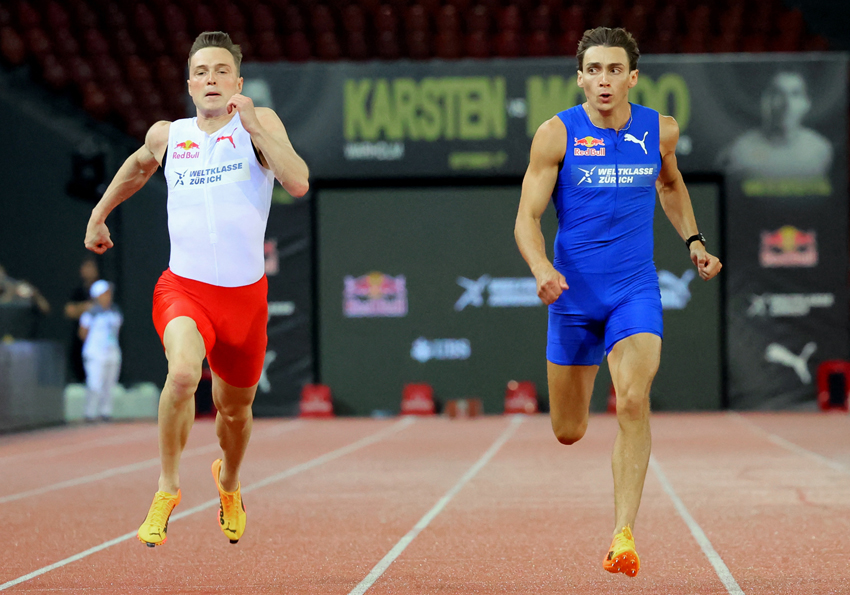Lactate: How to boost lactate threshold and why it will lift your performances
After 12 weeks, there was no change at all in VO2max, but the resistance exercisers did improve quadriceps and hamstring strength dramatically and bolstered endurance time during an intense exercise test by about 33 per cent (from 26 to 35 minutes). Most impressively, LT advanced by a full 12 per cent ('Effects of Strength Training on Lactate Threshold and Endurance Performance,' Medicine and Science in Sports and Exercise, vol. 23(6), pp. 739-743, 1991).
Why did the circuits hoist LT upward? The key researcher involved in the study, Ben Hurley, PhD, theorized that 'resistance training improved the power of individual muscle cells, so not as many powerful 'fast-twitch' fibres needed to be recruited during exercise'. Since fast-twitch cells are notorious for producing lactate, their reduced activation should lead to lower lactate outputs during exertion and thus a potentially higher lactate threshold.
However, there's also another possibility: as muscular strength increases, better whole-body stability can be attained during exercise. As whole-body stableness improves, there is a reduced need to expend energy compensating for unnecessary motions - bringing the body back into proper position for optimal movement. Thus, a greater percentage of muscular force production can be channelled into forward propulsion, rather than the correction of sloppy movements. This should heighten speed at all fractions of VO2max, including LT, and thus raise LT velocity. However, it's important to note that the strength routines which are most likely to hike LT are the ones which upgrade whole-body strength, such as push-ups and feet-elevated push-ups, body-weight squats, squat thrusts with jumps (burpees), squat and dumbbell presses, bench dips, 'core exercises,' and lunges, as well as exertions which mimic the movements involved in running, including one-leg squats, high-bench step-ups, and one-leg hops in place. Routines which isolate muscles or which are poorly related to the actual biomechanics of movement (eg, single-joint movements on weight machines) are probably much less likely to benefit LT.
Rest to improve LT?
As with any particular type of training, rest is also important for maximizing LT. In a study carried out at the University of Alberta in Canada, a group of well-conditioned athletes trained strenuously for a six-week period and then cut back on training dramatically over a six-day period, resting completely for two of the six days, cutting normal workout duration by 67 per cent on two other days, and trimming sessions by 33 per cent on the other two days. This reduced-training group was compared with another group of athletes who simply kept on training at usual levels - and with a third group who did no training at all during the six days ('The Effects of a Reduced Exercise Duration Taper Program on Performance and Muscle Enzymes,' European Journal of Applied Physiology, vol. 65, pp. 30-36, 1992).
Although LT was the same in all three groups at the end of the six-week training period (and just before the six-day experimental period), there were major differences after the six days of rest or work were over. Basically, the reduced-training group lifted LT by slightly over 10 per cent, the group which rested completely failed to improve LT, and the group which continued to train hard actually experienced a deterioration of LT! There's an important lesson here: at least every six weeks (and for some athletes it should be every three to four weeks), training should be reduced significantly for six or seven days to allow muscles to recover from strenuous training and create the new structures and enzymes which will raise LT and also improve performance. Constant hard training can be the ruination of a quality LT.
A very fast LT workout
Since lactate levels in the blood - and thus LT - are a function of both the rate at which lactate pours into the blood and the rate at which muscles remove lactate from the bloodstream, it seems certain that in order to optimize LT some workouts should be planned which improve the ability of muscles to seize lactate and break it down for fuel. Research shows that muscles can indeed learn to 'clear' lactate at advanced rates, provided the training stimulus is appropriate ('Endurance Training Increases Skeletal Muscle Lactate Transport,' Acta Physiologica Scandinavica, vol. 147(3), pp. 323-327, 1993).
It's obvious that such workouts should involve fairly heavy lactate production, since modest amounts of lactate probably won't 'teach' muscles to enhance their lactate-clearance capabilities. Workouts which involve fairly heavy lactate outputs should also improve the 'buffering capacity' of muscles, ie, their ability to cope with the upward zooms in acidity associated with very intense efforts ('kicks' to the finish line, mid-race surges to lose troublesome opponents, and lung-searing hill climbs at key stages of a competition).
Research carried out at Iowa State University indicates that such a 'lactate-clearance' and 'muscle-buffering' workout might involve a good warm-up and then a number of two-minute intervals carried out at very close to maximal intensity, tempered with four-minute recoveries between work intervals ('Lactic Acid Tolerance Training: Floods of Lactic Acid Aren't Necessarily Bad - If You Can Endure Them', Running Research News, vol. 8(6), pp. 1-4, 1992). Of course, the purpose of the two-minute blasts is to produce lots of lactate, while the rationale for the four-minute recoveries is to coax the muscle cells into increasing their ability to metabolize the lactate produced - as well as provide enough 'down' time so that the next two-minute work interval can be conducted at a very hard intensity which 'spills out' a lot of lactate.
Can increased training volume by itself increase LT? Yes, but the effect will be most pronounced in fairly unfit, non-experienced athletes who are raising their training volume significantly for the first time. Research carried out with previously sedentary lab rats found that rodents who ran for two hours per day increased mitochondrial enzymes much more than rats who scurried along for one hour daily (more mitochondrial enzymes usually mean a higher LT). In turn, the one-hour rats fared better than 30-minute per day trainees, which did better than rodents who hustled along for only 10 minutes a day. The two-hour animals were also able to keep up a bristling treadmill pace for over twice as long as any of the other groups ('Skeletal Muscle Respiratory Capacity, Endurance, and Glycogen Utilization,' American Journal of Physiology, vol. 228(4), pp. 1029-1033, 1975). In experienced athletes, however, increased volume is much less likely to produce such striking effects on mitochondrial enzymes and LT. Scientific research consistently shows that increases in intensity work better than hikes in volume at boosting LT.
An LT-boosting programme
Overall, an optimal seven-week period (including six weeks of work and one week of rest) for enhancing LT might proceed as follows (only the quality workouts are described; the rest of the weekly training would involve easy efforts; you'll note that the LT workouts increase in difficulty over the six-week period):
Week 1:
LT Session 1: Warm up, and then run for 20 minutes at a pace which is 10 to 12 seconds slower per mile than your current 10-K tempo (for cyclists and swimmers, exercise for 20 minutes at 85 per cent of max heart rate). Cool down with 15 minutes of easy effort.
LT Session 2: Warm up, and then run three to four one-mile intervals at your current 10-K pace (for cyclists and swimmers, exercise for three to four seven-minute intervals at 90 per cent of max heart rate), with three-minute recoveries in between. Cool down with two easy miles.
Week 2:
LT Session 3: Warm up, and then perform the following activities in order:
1. Run 3/4 mile at your current 10-K pace (or cycle or swim for four to five minutes at 90 per cent of max heart rate)
2. Do 50 ab crunches
3. Complete 5 chin-ups
4. Perform 15 push-ups
5. Complete 30 body-weight squats (fast)
6. Do 20 squat thrusts with jumps (burpees)
7. Run 3/4 mile at 10-K pace again
8. Perform 8 feet-elevated push-ups
9. Do 50 low-back extensions
10. Complete 15 bench dips
11. Do 15 squat and dumbbell presses with 10-pound dumbbells
12. Perform 20 lunges with each leg
13. Run 3/4 mile at 10-K pace again
14. Cool down with 15 minutes of light activity
Alternative-Emphasis Workout (for VO2max): Warm up, and then run four to six 800s at or slightly faster than current 5-K pace (or cycle or swim for three minutes at an intensity which brings heart rate up to 95 per cent of max near the end), with equal (in time) recoveries. Cool down with 15 easy minutes.
LT Session 4: Exercise continuously for one and one-half to two times the distance of your average daily training session, working hard on all uphills.
Week 3:
LT Session 5: Warm up, and then run for two miles continuously at your current 10-K pace (or swim or cycle for 14 minutes at 90 per cent of max heart rate). Recover for five minutes, and then run two more miles at 10-K pace. Cool down with 15 minutes of easy activity.
Alternative-Emphasis Workout (for economy): Hill repeats
Week 4:
LT Session 6: Warm up, and then ramble for 25 minutes at a pace which is 10 to 12 seconds slower per mile than your current 10-K tempo (or cycle or swim for 25 minutes at 85 per cent of max heart rate). Cool down with 15 light minutes.
LT Session 7: Warm up, and then run four six-minute intervals at your current 10-K pace (or cycle or swim for 4 x 6 minutes at 90 per cent of max heart rate), with only three minutes of recovery between intervals. Cool down with two easy miles.
Alternative-Emphasis Workout (for general endurance): Exercise continuously and at a moderately hard intensity for about two times the distance of your average daily workout.
Week 5:
LT Session 8: Warm up, and then perform the following activities in order:
1. Run 1/2 mile at your current 10-K pace (or cycle or swim for three minutes at 90 per cent of max heart rate)
2. Do 30 ab crunches
3. Complete 4 chin-ups
4. Perform 12 push-ups
5. Complete 20 body-weight squats (fast)
6. Do 15 squat thrusts with jumps (burpees)
7. Run 1/2 mile at 10-K pace again
8. Perform 7 feet-elevated push-ups
9. Do 30 low-back extensions
10. Complete 10 bench dips
11. Do 10 squat and dumbbell presses with 10-pound dumbbells
12. Perform 15 lunges with each leg
13. Run 1/2 mile at 10-K pace again
14. Repeat steps 2-13 one more time (for two circuits in all)!
15. Cool down with 15 very light minutes
LT Session 9: Warm up, and then complete eight two-minute intervals at close to maximal pace, with easy, four-minute jog recoveries in between. Cool down with 15 easy minutes.
Week 6:
LT Session 10: Warm up, and then complete four seven-minute intervals at your current 10-K pace (at 90 per cent of max heart rate for swimmers and cyclists), with only two minutes of recovery between intervals. Cool down with two miles of light jogging.
Alternative-Emphasis Workout (for economy): Hill repeats
LT Session 11: Exercise continuously for one and one-half to two times the distance of your average daily training session, working hard on all uphills, and maintaining an intensity which feels moderately hard.
Week 7:
Recovery: Cut total training volume to one-third of normal levels and exercise easily all week, with one minor exception: About mid-week, warm up and then run six to eight 400s at 5-K pace (cyclists and swimmers should complete 6 to 8 x 90 seconds at an intensity which brings heart rate up to 95 per cent of max at the end of each interval), with one- to two-minute recoveries. At the end of this week, you'll have a stunning new LT!
LT-type training, which includes fartlek, interval, and more sustained running at speeds ranging from 5-K to 10-mile pace (or at intensities ranging from 85 to 95 per cent of max), can produce a true transformation in your athletic capacity, but don't forget that it needs to be balanced with other forms of work. You should always build a good 'base' of both mileage and strength before you undertake LT training, and you should devote just four to six weeks at a time to strenuous LT efforts, shifting over to other key training emphases (VO2max, economy, power, etc.), as your needs dictate. If you return to LT-building periods of training every 12 to 18 weeks or so, the most consistent thing about your performances will be your steady improvement!
The bottom line? On average, if you're a runner and you improve your LT by 3 per cent, your 10-K times will also improve by 3 per cent. Raise LT by 10 per cent - and your 10-K finishes will be 10 per cent better. Lift LT by 20 per cent - and you will truly shock your running acquaintances with your 20-per cent upswing in 10-K speed (Journal of Applied Physiology, vol. 58(4), pp. 1281-1284, 1985). So - it's time to get started on your LT lift-off!
Owen Anderson
You need to be logged in to continue reading.
Please register for limited access or take a 30-day risk-free trial of Sports Performance Bulletin to experience the full benefits of a subscription. TAKE A RISK-FREE TRIAL
TAKE A RISK-FREE TRIAL
Newsletter Sign Up
Testimonials
Dr. Alexandra Fandetti-Robin, Back & Body Chiropractic
Elspeth Cowell MSCh DpodM SRCh HCPC reg
William Hunter, Nuffield Health
Newsletter Sign Up
Coaches Testimonials
Dr. Alexandra Fandetti-Robin, Back & Body Chiropractic
Elspeth Cowell MSCh DpodM SRCh HCPC reg
William Hunter, Nuffield Health
Keep up with latest sports science research and apply it to maximize performance
Today you have the chance to join a group of athletes, and sports coaches/trainers who all have something special in common...
They use the latest research to improve performance for themselves and their clients - both athletes and sports teams - with help from global specialists in the fields of sports science, sports medicine and sports psychology.
They do this by reading Sports Performance Bulletin, an easy-to-digest but serious-minded journal dedicated to high performance sports. SPB offers a wealth of information and insight into the latest research, in an easily-accessible and understood format, along with a wealth of practical recommendations.
*includes 3 coaching manuals
Get Inspired
All the latest techniques and approaches
Sports Performance Bulletin helps dedicated endurance athletes improve their performance. Sense-checking the latest sports science research, and sourcing evidence and case studies to support findings, Sports Performance Bulletin turns proven insights into easily digestible practical advice. Supporting athletes, coaches and professionals who wish to ensure their guidance and programmes are kept right up to date and based on credible science.









